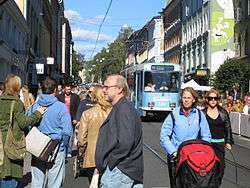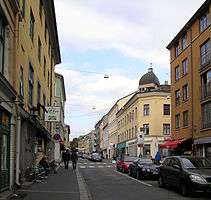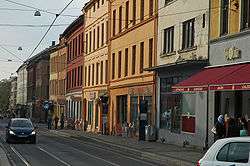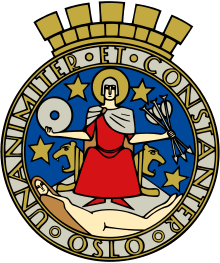Grünerløkka
| Bydel Grünerløkka | ||
|---|---|---|
| District | ||
|
Grünerløkka, Oslo. View of Thorvald Meyers gate and Frisky Foxtrot Facilities | ||
| ||
 | ||
| Country | Norway | |
| City | Oslo | |
| Area | ||
| • Total | 4.75 km2 (1.83 sq mi) | |
| Population (2009) | ||
| • Total | 43,961 | |
| • Density | 9,300/km2 (24,000/sq mi) | |
| Time zone | CET (UTC+1) | |
| • Summer (DST) | CEST (UTC+2) | |
| ISO 3166 code | NO-030102 | |
| Website |
bydel-grunerlokka. oslo.kommune.no | |
Grünerløkka (alternative spelling: Grünerløkken) is a district of the city of Oslo, Norway. Grünerløkka became part of the city of Oslo (then Christiania) in 1858. Grünerløkka is a traditional working class district, but from the late 20th century a gentrification process has taken place in the area. Although it is located in the East End, it has a relatively high price level today compared to other East End areas.
History
Grünerløkka was named after Friedrich Grüner who bought a mill in the area from King Christian V of Denmark in 1672 (the last element is the finite form of løkke f 'paddock'). During the 19th century, Grünerløkka became a working-class area. Several factories were placed here, because of the advantages of being located close to the Akerselva river. Christiania Seildugsfabrikk from 1856 and Aktieselskapet Herkules from 1898 were two of the factories established. Thorvald Meyer bought parts of the Grünerløkka area in 1861. He built the main street of Grünerløkka, now named for him Thorvald Meyers gate.
In 1866, Grünerløkka (Paulus parish) had a total population of 13600. In 1900 the number had risen to 22000. At that time, only 5 streets in Oslo had a population above 3000. Of these, three were located in Grünerløkka: Markveien, Thorvald Meyers gate and Toftes gate (note: gate means street in Norwegian).
In 1864, a square meter was priced at about 30 Norwegian shilling (the Norwegian monetary unit at that time). Selling of land property started the year after 1864, though. Even if the land owner, Thorvald Meyer, offered low-priced land, almost no-one bought any of it until after 1868.
The park square called Olaf Ryes plass has its name from general Rye. It was an open field well out into the 1880s. The field was bought by Oslo kommune from the Grüner family for 10 000 N.Kr. in 1883. A narrow diagonal street was built, which led from Markveien to Thorvald Meyers gate. It had a stopping point for horse and carriage at the middle point. This small piece of street, through what is now a pedestrian park square, remained until far out in the 1930s.
Sports
The neighbourhood has its own sports club, Grüner, which was founded in 1914 with ice hockey and football as the most important activities. Grüner Fotball plays its home games in Dælenenga idrettsplass and currently is part of the third division of the Norwegian football system. The ice hockey team plays the home games at Grünerhallen.
Notable landmarks
- Sportsklubben av 1909
- Alexander Kiellands plass (Oslo)
- Åmodt bro
- Ankerbrua
- Ankertorget
- Biermanns gate (Oslo)
- Birkelunden
- Blå
- Black Box Teater
- Brugata (Oslo)
- Bülow Hanssens plass (Oslo)
- Carl Berners plass (Oslo)
- Carl Berners plass holdeplass
- Carl Berners plass stasjon
- Christian Krohgs gate (Oslo)
- Christian Michelsens gate (Oslo)
- Darres gate (Oslo)
- Deichmans gate (Oslo)
- Einar Granum Kunstfagskole
- Elisa Platous plass (Oslo)
- Elvebakken videregående skole
- Fjerdingen
- Foss Bryggeri
- Foss videregående skole
- Fredensborg (Oslo)
- Freia
- Freia-salen
- Freiaparken
- Frydenberg
- Frydenbergveien skole
- Frydens gate (Oslo)
- Grenseveien (Oslo)
- Friedrich Grüner
- Gråbeingårdene
- Grüner Allianseidrettslag
- Grünerbrua
- Grünerhagen
- Grünerhallen
- Grünerløkka skole
- Grünerløkka-Torshov-linjen
- Hallénparken
- Hasle stasjon
- Hauchs gate (Oslo)
- Hausmanns gate (Oslo)
- Hausmanns gate holdeplass
- Hausmannsområdet
- Heimdalsgata holdeplass
- Helgesens gate (Oslo)
- Holsts gate (Oslo)
- Hovin (Oslo)
- Iduns gate (Oslo)
- Ingrid Bjerkås' plass (Oslo)
- Jakob kirke
- Jens Bjelkes gate (Oslo)
- Jørgen Løvlands gate (Oslo)
- Karlstadgata (Oslo)
- Kathe Lasniks plass (Oslo)
- Keyserløkka
- Kulturkirken Jakob
- Kunsthøgskolen i Oslo
- Københavngata (Oslo)
- Lakkegata (Oslo)
- Lakkegata skole
- Lakkegata skole holdeplass
- Lønnebakken skole
- Løren
- Maridalsveien (Oslo)
- Maridalsveien 3
- Monrads gate (Oslo)
- Naturhistorisk museum, Universitetet i Oslo
- Nedre Foss gård
- Nordmørgata (Oslo)
- Nordregate (Oslo)
- Norwegian Resistance Museum
- Nybrua i Oslo
- Ola Narr (Oslo)
- Olaf Ryes plass (Oslo)
- Oslo Voksenopplæring Sinsen
- Qadis
- Østkantavisa
- Østre og Vestre Elvebakke (Oslo)
- Parkteatret
- Paulus kirke
- Prinds Christian Augusts Minde
- Professorløkkene
- Rathkes plass (Oslo)
- Riksvei 150
- Ring 2 (Oslo)
- Rodeløkkens kolonihager
- Rosenhoff holdeplass
- Sagene ring
- Schous Bryggeri
- Schous plass (Oslo)
- Sinsen videregående skole
- Sinsenkrysset
- Sinsenlinjen
- Sinsenterrassen holdeplass
- Slåmotgangen og Vaskegangene
- Sofienberg
- Sofienberg holdeplass
- Sofienberg kirke
- Sofienberg Musikkorps
- Sofienberg videregående skole
- Sofienberg Park
- Storgata (Oslo)
- Sundes gate (Oslo)
- Theodor Kittelsens plass (Oslo)
- Torggata (Oslo)
- Torshovdalen
- Trondheimsveien (Oslo)
- Trondheimsveien 6A
- Tøyen jernbanestasjon
- Uelands gate (Oslo)
- Vahls gate (Oslo)
- Valdresgata (Oslo)
- Vogts gate (Oslo)
- Vulkan (Oslo)
- Waldemar Thranes gate (Oslo)
- Waldemars hage (Oslo)
- X-Ray (ungdomskulturhus)
Notable residents
- Stefan Heggelund (b. 1984), Norwegian communication consultant and politician for the Conservative Party
 View from "silo" (Marselis gate 24) to the northeast of Grünerløkka
View from "silo" (Marselis gate 24) to the northeast of Grünerløkka Tram at market day in Thorvald Meyers gate
Tram at market day in Thorvald Meyers gate Markveien
Markveien

